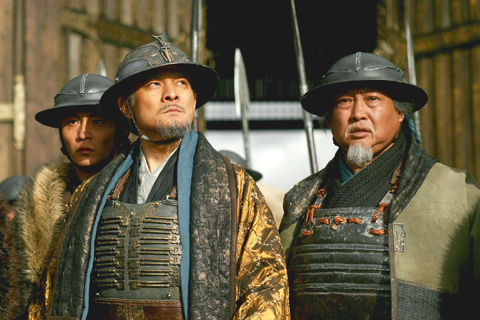The Three Kingdoms period (168 AD to 280 AD), one of the bloodiest in Chinese history, has captured imaginations for centuries. Its warlords, heroes and battles have been romanticized in novels, folktales and, in more recent times, television series, video games and films. For his film about the period when ancient China was divided into the warring kingdoms of Wei, Shu and Wu, Hong Kong director Daniel Lee (李仁港) has gathered together yet another cast of big-name stars to tell a story not about the oft-celebrated Liu Bei (劉備), Guan Yu (關羽) or Zhang Fei (張飛), but about the dutiful general Zhao Zilong (趙子龍) from the kingdom of Shu.
The film begins when a young Zilong (Andy Lau, 劉德華) leaves home to serve in the army of Liu Bei. He and fellow countryman Pingan (Sammo Hung, 洪金寶) swear an oath of brotherhood, pledging to help unite their divided country. Clever and courageous, Zilong soon makes a name for himself on the battlefield and becomes one of the five great commanders of the kingdom of Shu.
Time passes and most of the five generals died on the battlefield. The legendary military strategist and statesman Zhuge Liang (諸葛亮) makes one final attempt to honor the dying wish of Liu Bei to defeat the kingdom of Wei, and the gray-haired Zilong volunteers to lead the troops.

PHOTO COURTESY OF SCHOLAR FILMS
Pingan’s unexpected betrayal results in Zilong’s force being besieged by a Wei army headed by Cao Ying (Maggie Q), the resourceful granddaughter of the infamous warlord Cao Cao (曹操). The aged general is grievously wounded and looks back on his life before bravely sallying forth to meet his fate.
With a joint Chinese-South Korean investment of more than US$27 million, this epic war film has all the attributes of a blockbuster in the making: a big-name cast, slick production values, and massive battle scenes said to have employed as many as 40,000 extras. Beautifully shot with an atmospheric palette of yellow, blue and green, the film effectively conveys a sense of cruelty and barrenness on a sandy plain where blood and sweat glitter under a scorching sun. Bright sunlight and shade emphasize the lines etched on the warriors’ faces as they howl and slash their way through the battlefield.
Commendable visuals aside, Three Kingdoms suffers from a linear, sometimes tedious narrative driven by fast-paced editing and a monotonous voice-over by Sammo Hung’s character.
Veteran actor and martial arts choreographer Hung furnishes the fight scenes with polished moves and kicks. But sometimes it can be too much. It is almost comic to watch Lau’s character single-handedly take Chinese heroism to another level as he successfully fights his way through a legion of armored soldiers with a crying baby tied to his back.
For those whose Three Kingdoms fix isn’t satisfied by this movie, John Woo’s (吳宇森) highly anticipated martial arts epic Red Cliff (赤壁) is scheduled to hit the big screen in July.

Wooden houses wedged between concrete, crumbling brick facades with roofs gaping to the sky, and tiled art deco buildings down narrow alleyways: Taichung Central District’s (中區) aging architecture reveals both the allure and reality of the old downtown. From Indigenous settlement to capital under Qing Dynasty rule through to Japanese colonization, Taichung’s Central District holds a long and layered history. The bygone beauty of its streets once earned it the nickname “Little Kyoto.” Since the late eighties, however, the shifting of economic and government centers westward signaled a gradual decline in the area’s evolving fortunes. With the regeneration of the once

Even by the standards of Ukraine’s International Legion, which comprises volunteers from over 55 countries, Han has an unusual backstory. Born in Taichung, he grew up in Costa Rica — then one of Taiwan’s diplomatic allies — where a relative worked for the embassy. After attending an American international high school in San Jose, Costa Rica’s capital, Han — who prefers to use only his given name for OPSEC (operations security) reasons — moved to the US in his teens. He attended Penn State University before returning to Taiwan to work in the semiconductor industry in Kaohsiung, where he

In February of this year the Taipei Times reported on the visit of Lienchiang County Commissioner Wang Chung-ming (王忠銘) of the Chinese Nationalist Party (KMT) and a delegation to a lantern festival in Fuzhou’s Mawei District in Fujian Province. “Today, Mawei and Matsu jointly marked the lantern festival,” Wang was quoted as saying, adding that both sides “being of one people,” is a cause for joy. Wang was passing around a common claim of officials of the People’s Republic of China (PRC) and the PRC’s allies and supporters in Taiwan — KMT and the Taiwan People’s Party — and elsewhere: Taiwan and

Perched on Thailand’s border with Myanmar, Arunothai is a dusty crossroads town, a nowheresville that could be the setting of some Southeast Asian spaghetti Western. Its main street is the final, dead-end section of the two-lane highway from Chiang Mai, Thailand’s second largest city 120kms south, and the heart of the kingdom’s mountainous north. At the town boundary, a Chinese-style arch capped with dragons also bears Thai script declaring fealty to Bangkok’s royal family: “Long live the King!” Further on, Chinese lanterns line the main street, and on the hillsides, courtyard homes sit among warrens of narrow, winding alleyways and